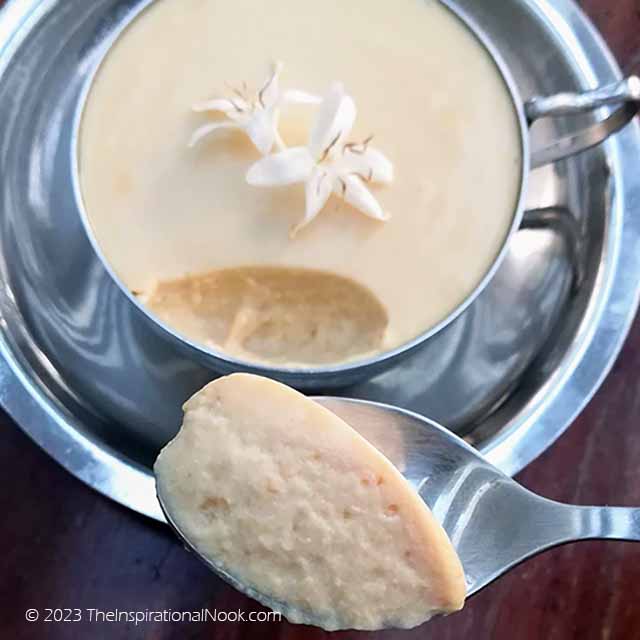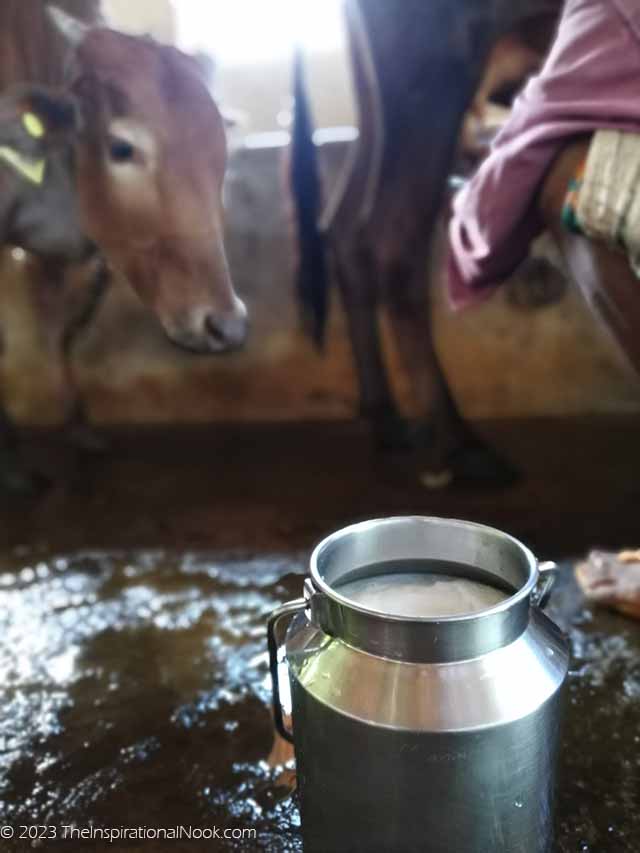I'm suffering from a dreadful case of foot and mouth. Always one to exaggerate just a teeny weeny bit, this time I've really put my foot in it.
I'm holidaying with Hansom Hubby and family in a lush coffee plantation nestled in the Western Ghats of India in Chickmagalur. Weaving through the working farm across the coffee drying yards and between the cow sheds I announced quite presumptuously that I have many special hidden talents.
"You know, if we had time, I'd milk one of these cows and make a damn fine Mishti Doi dessert for you all."
I didn't expect anyone to take me up on the offer. We have time. Lots of it, they all declared. We'd love to see you milk a cow and taste your fine dessert.
 |
Success!
Mishti Doi that I made with milk from cows I milked on location at a Chickmaglur coffee plantation. |
"I don't think she can," twinkled my brother. "But it would be an awful lot of fun to see her get kicked by the cow."
So terribly supportive.
"Oh, yes she can," said Hansom Hubby fiercely and clearly clueless of my abilities.
So wonderfully supportive.
"Well, let's put some money on it to make it interesting, shall we?"
So, now that frivolous words have been uttered, bets have been made and reputations are at stake, I find myself standing at the entrance to the cowshed, bemused cows before me, amused betters behind me.
And in case you are wondering, I have never milked a cow. Nor have I made Mishti Doi before. But I'm also never one to turn down a challenge... so here goes.
How To Milk A Cow

Kavitha, the farm worker, has selected Lakshmi, the meekest cow of the lot for me to milk. Apparently, Lakshmi will tolerate tactless tugging at her udder, so I'm told.
"Are you sure that's not a bull? It has got horns," calls out my brother. The peanut gallery collapses in a heap of laughter. But I will not be deterred.
Kavitha first unties Lakshmi's calf, who makes a dash to Lakshmi's udder. The calf stimulates the milk production and this is a required step before the milking process can begin.
After a couple of minutes, Kavitha decides the calf has had enough to drink. With an impressive latent strength, this lithe little worker quickly and powerfully drags the calf away and tethers the salivating baby just out of reach.
Kavitha then cleans and washes Lakshmi's udder. She then greases the udder before demonstrating to me how to milk a cow. Grab onto a teat firmly with your thumb and forefinger, as high up on the udder as possible. Squeeze and run your thumb and forefinger right down along the the length of the teat, maintaining the pressure to squeeze out the milk in a nice tight stream. Push up into the udder and repeat. Maintain a good rhythm.
That looks easy!
God knows, it's not.
I approach Lakshmi warily. The peanut gallery has suddenly grown quiet. I squat down carefully. So here I am, face-to-udder with this cow. Her right leg seems alarmingly close to my face. I sure hope that they're right about this one not being a kicker.
I hold onto her teat. It's warm and greasy. Feels a bit strange. And then I pull down.
Nothing happens.
Lakshmi turns and looks at me.
Holy Cow! Her horns seem awfully close to me.
I try again.
Nothing.
Except this time, Lakshmi flicks my face hard with a quick swish of her tail. I suppose this is a cow's way of flipping me off.
I'll take it. Better than this big girl stepping on my toes with her 1,000 pounds of voluptuousness.
Kavitha moves in to demonstrate again. Don't be nervous, get closer to the cow, squeeze and pull harder.
So that's what I do, with what I think is an inordinate amount of pressure to exert on one's nipples. Forgive me, Lakshmi, for my insensitive groping.
And then, a thin stream of milk flows out and hits the milk can making the loveliest, most resonant sound I've heard.
Hurrah, I did it!
In no time, I'm working the udder and the thick, warm milk is streaming out into a frothy mass of goodness collecting in the can below. The peanut gallery has exploded with mass approval.
I feel a great sense of satisfaction and appreciation as I carry the can of warm milk carefully back to the house. I did it!
I still had to make the Mishti Doi dessert. But that would be a piece of cake. Now that I had the milk.
Milking a cow has heightened my awareness and appreciation of where milk actually comes from.
Something that buying milk from a supermarket and pouring it out of a carton had totally desensitized and disconnected me from the source of our food.
Mishti Doi | India's Greek Yoghurt
Mishti Doi is a classic Bengali sweet made with milk, curd, jaggery or sugar. I first had it at the K.C. Das Sweet Shop where the sweetened curd is poured into small clay pots or matkas and left to set. It is served in these earthen clay pots which keeps the curd cool in the days when refrigeration didn't exist.
Mishti Doi is India's version of thick, sweetened Greek Yogurt.
Mishti means sweet in Bengali and doi means yogurt.
In Hindi, it would be Mithi (sweet) dahi (yogurt), but Bengalis have a richer way of pronouncing things.
Since I was using fresh cow's milk to make the Mishti Doi, I first had to make curd/ yogurt out of the cow's milk before I could start making the Mishti Doi. This made things longer since there were 2 fermentations.
My recipe below is made by starting with store bought yogurt to shorten the process. It makes a lightly sweet dessert. Add more sugar to the recipe if you want a sweeter Mishti Doi.
 |
| My rich and thick Mishti Doi made with fresh cow's milk. Garnished with coffee blossoms. |
Ingredients:
☐ 2 cups thick curd/ yoghurt
☐ 2 cups whole milk
☐ 1/2 cup sugar
Step-by-Step Instructions
Step 1: Make Hung Curd/ Yoghurt
- To make the thick curd/yoghurt, place a muslin cloth in a sieve and place the sieve over a vessel to collect the whey.
- Put the 2 cups of yoghurt in the muslin cloth and set aside for an hour so that the whey can drain out.
- After an hour, twist the muslin cloth to gently squeeze out any more liquid from the yoghurt. What remains is a thick curd/yoghurt.
Step 2: Make Caramelized Milk
-
Place sugar in a heavy bottomed pan and begin to heat it.
- As the sugar starts to melt it, stir it to so that it melts evenly and turns liquidy and brown.
- When the sugar has completely melted and is golden brown in colour, lower the flame and carefully add 1 cup of hot milk. Take care, as the sugar will splutter when the milk is added. Stir continuously to combine the caramelized sugar with the milk. Pour the remaining hot milk into the mixture and combine well to make the caramel milk. Remove from heat and set aside to cool.
Step 3: Make the Mishti Doi Mixture
- Place the thick, hung curd in a vessel and whisk lightly until smooth.
- Add 1 cup of lukewarm caramel milk to the curd and whisk to combine. Note: The caramel milk should be very slightly warm. If the milk is too hot, it will curdle the mixture.
- Add the remaining caramel milk and whisk lightly to make the Mishti Doi mixture.
Step 4: Set the Mishti Doi
- Pour the mishti doi mixture into 4 small clay pots or katoris.
- Cover and set aside in a warm place for about 6 hours to allow the curd to set.
Step 5: Serve
- After the Mishti Doi has set, you can serve it.
- If eating it later, refrigerate it and serve it cold, to prevent the curd from fermenting further.
For more of my adventures with Hansom and my recipe for Banana Rum Loaf, read:






